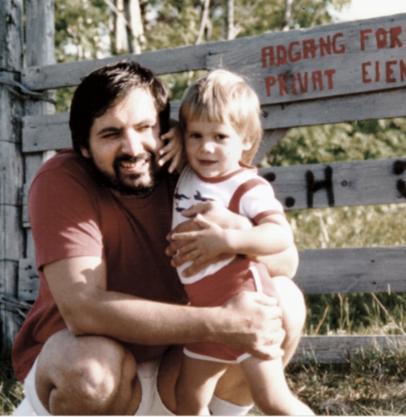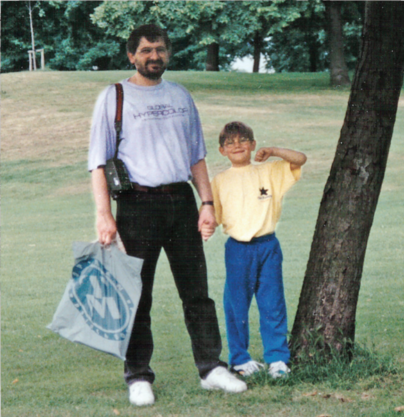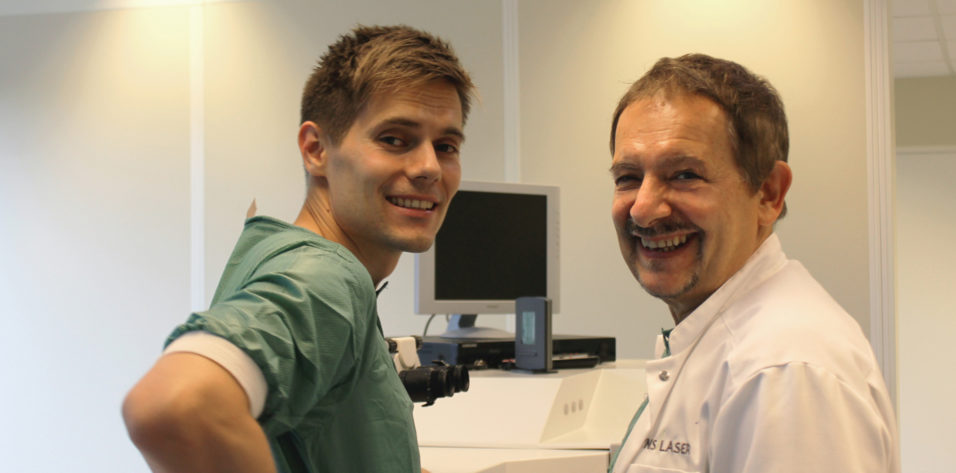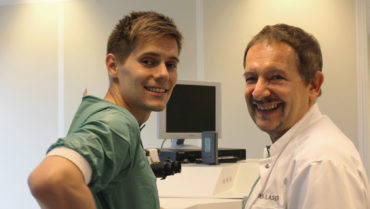From Dream Theater to Operating Theater
By Aleksandar Stojanovic, MD
As my son Filip was growing up (Figures 1 and 2), I continually tried to bridge the generation gap between us by staying current with his interests and exposing him to mine. In his early years, I learned all about Teenage Mutant Ninja Turtles. Later, I learned to enjoy heavy metal music, and I took him and his friends to a concert by Dream Theater. But he also let me take him to Pink Floyd and Roger Waters concerts, and I turned him on to the thinking of Carl Sagan.

Figure 1. Three-year-old Filip, with his father Aleksandar.

Figure 2. Aleksandar and Filip, circa 1994.
All parents wish to remain close to their children as long as possible, but, in most cases, when children become adults, they tend to drift away from their parents as the realities of busy adult life take their toll. In our case, however, having a common profession helps us to maintain the closeness, especially as that common profession is ophthalmology.
Our field contains enormous space for engaging in communication, from sharing a challenging case or an interesting technique, to participating in a common research project, to traveling together to ophthalmology congresses. I think it is a dream come true for any parent to contribute to the growth of one’s child in such an exciting field like ours.
THE HUMAN SIDE of things
Filip always loved science, but he also has exceptional sensitivity to the human side of things, with a high level of empathy in any communication. I felt that such a combination made him suitable for a career in medicine. I guess he sensed that too, as that is the path he chose.
At the time when I started looking into CXL and the corneal penetration and concentration of riboflavin, I needed to revisit some long-forgotten physics and chemistry. Filip was a medical student at that time, with fresh knowledge of the subject, and I asked him for his help. As a result of his involvement, he got so interested in the subject that he did a fine presentation about it at the American Congress of Ophthalmic Surgery (now American-European Congress of Ophthalmic Surgery [AECOS]) meeting in Utah in 2010, and he even chose it as the subject for his graduation thesis. After that, there was no question of which direction he was going in his medical career.
In my own work, I am mostly involved in the diagnosis and treatment of keratoconus and irregular astigmatism, as well as research concerning corneal diagnostics and the ablation design of topography-guided treatments of complex cases. Filip, still being fan of science, and especially physics, will in my opinion fit in well in these areas, and I intend to increasingly engage him in my research projects—as soon as he feels that he can spare some time from his busy ophthalmology residency.
Growing Up in the Office
By Filip Stojanovic, MD
Growing up with my father and seeing him enjoy his work was a big part of why I became interested in medicine. I was exposed to ophthalmology quite early in my life, and I have memories of visiting his practice after elementary school to observe him while he examined and treated patients. As I grew older, I got to assist with patient examinations, usually performing easy tasks such as autoperimetry and autorefractometry. Growing up like this definitely honed my interest in medicine.
From 6 to 16 years of age, I thought of helping out in the office as a cool way to spend time with my dad, not paying too much attention to exactly what was going on. By the time I was 18, however, I became involved in regularly helping prepare patients for refractive surgery, and I grew more interested in the subject of ophthalmology itself.
I also joined my father on many of his travels to the European Society of Cataract and Refractive Surgeons (ESCRS) and American Society of Cataract and Refractive Surgery (ASCRS) meetings to watch him present his papers; this exposure hugely inspired me to follow in his footsteps.
A LOVE OF THE TECHNICAL
After medical school, I got a job as a resident in the ophthalmology department at the University Hospital of North Norway. I have now been working there for more than 1 year. I love how ophthalmology combines almost every aspect of medicine, from simply talking to patients, to using advanced high-tech diagnostic methods, to performing microsurgery. Because I am a huge fan of basic science, I especially like the technical aspects of ophthalmology.
As with anything, I want to strive to become the best that I can be. What this will entail, I am not quite sure, but I can attest that I am interested in surgery, research, and teaching. I would love to work alongside my father some day. I still have a long way to go, so we shall see what the future will bring.


